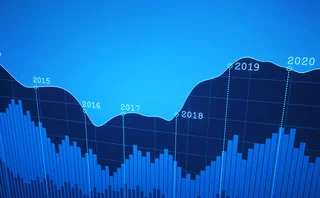
Emerging issues
Fears of a rise in US interest rates have sparked a sell-off in emerging market debt, causing spreads to blow out. Julian Evans asks whether there is anything fundamentally wrong with the markets

Emerging market debt suffered its worst drop in four years throughout late April and early May, as fears of steep Fed rate hikes prompted a big sell-off in emerging market debt, mainly by highly leveraged hedge funds. As one investment bank head of EM debt puts it, “We’re in the middle of a very, very violent correction.”
The JPMorgan Emerging Market Bond Index (Embi) fell from 281 basis points on April 27 to 264bp on May 12, prompted initially by strong new US employment figures, which reflected better-than-expected US economic growth. Spreads on benchmark issues from Brazil, Russia, Turkey and the Philippines all widened by around 100 basis points as the market predicted a Fed rate rise as early as June.
Peter Malik, head of emerging market syndicate for central and eastern Europe, the Middle East and Africa at CSFB, says, “The consensus had been that you wouldn’t see any rate increase until at least the first quarter 2005, if not later. The forward rate market was predicting possibly a 25bp rise in November 2004, while most economists were predicting a 25bp rise at some point well into 2005.”
In the middle of April, that changed. US macroeconomic numbers, such as payroll figures and retail sales, came out much stronger than the market expected, so the consensus view changed abruptly to the belief that the Fed would hike rates substantially, possibly by 100bp this year. Says Malik, “The consequent impact on EM debt has been very severe.”
The root of the problem
The impact has been particularly hard on emerging market debt because, throughout the past two years, hedge funds have been borrowing money at favorable rates in the US and investing it in emerging market debt, where they can find attractive yields—known as a ‘carry trade’. As a result, several hedge funds have been very long on emerging market debt. As Jerome Booth, head of research at Ashmore Investment, says, “They’ve been waiting for a dip for 18 months.”
When hedge funds saw increasing signs throughout April of US economic growth and thus probable Fed rate rises, they began to aggressively short emerging market debt, betting the market would go lower and thereby exacerbating the downturn.
While several analysts and investors, such as Mohammad El-Erian, emerging market debt fund manager at Pimco, have been quick to point out the correction has everything to do with US interest rates, and little to do with emerging market fundamentals, some regional factors have hurt the markets.
In Brazil, sovereign bonds were hit by concerns over the political weakness of president Luiz Inácio Lula da Silva’s government, says Giancarlo Perrasso, head of emerging market research at WestLB in London. In Turkey, the likelihood of joining the EU seems to have been weakened by the ‘no’ vote in the Cyprus referendum and by negative comments by some European politicians on Turkey’s chances of joining the EU. And in Russia, the corporate bond market was hit in late April by a sudden glut of new issuance.
Ronald Schneider, head of global debt at Raffeisen Asset Management, says, “Gazprom did a $1.2 billion issue in late April. The lead-managers [CSFB and Deutsche Bank] pushed it through quite heavily, and it was perhaps a bit too big for the market. To get it sold, they priced it quite cheaply, and allocated it to a lot of short-term investors.” The deal priced at 8.65%, up from original price talk of 8.25%.
“Other investors started looking at their Russian debt and thinking it was too cheap,” says Schneider. JPMorgan’s Russian Corporate Bond Index fell around eight points the day after Gazprom’s issue. “Then Gazprombank tried to come two days later with a $1bn deal, which didn’t help. It was a turning point in market sentiment.” Gazprombank failed to close its deal and is still waiting to issue.
However, CSFB’s Peter Malik, while admitting that the market grew worse after the deal was issued, says, “I wouldn’t say it oversaturated the market and thus caused or accelerated the sell-off. This was a global problem.”
Nonetheless, the market for new Russian corporate issuance has now effectively closed, with planned issues by MTS, Gazprombank and Uralsib all being shelved, some perhaps indefinitely.
Vimpelcom did manage to issue a $250 million, five-year deal in early June. The deal was priced at 10%, which is around 1.25% higher than it would have been two months before. However, while some bankers were hoping that the Vimpelcom issue would reopen the market, bankers who worked on the deal say it may be the last new issue until September.
Bob Fernandez, co-head of emerging Europe debt capital markets at JPMorgan, which lead-managed the deal, says the new bear market conditions have made investors, particularly in the US, much more sensitive to political risk. “At the moment, US investors are steering well clear of Russian corporate debt because of the Yukos case,” he says.
The Russian government is engaged in a messy court case with Yukos, once the largest oil company in Russia. The company is now on the brink of bankruptcy as the government fights the oligarchs in charge of the company for control of its assets. Investors are worried that other Russian private assets could be similarly seized by the government.
Fernandez says, “US investors don’t want to touch Russian debt until the Yukos situation is cleared up. But most of the planned new issues are large 144A transactions, so I don’t think they will be able to come before September.”
On the other hand, the 10 new EU members appear to have already dropped their emerging market status. Both sovereign and corporate bonds issued from the new members have been remarkably unaffected by the correction in other emerging markets. Slovakia was able to close a €1 billion bond at the tightest spreads ever for a central and eastern European sovereign—33bp over Bunds. Dennis Holtzapffel, head of emerging market syndicate at UBS, says, “Accession debt has now completely decoupled from emerging market debt. It’s a separate asset class, with a different investor base.”
Despite the violent correction in emerging market debt, a consensus exists among bankers and investors that this is not a crisis comparable to those that hit the emerging markets in 1994, when US rate rises affected Latin American debt, or 1998, when Russia defaulted on $40 billion of its debt. In this instance, there is nothing systemically wrong with key emerging markets, and hedge funds are not such a powerful force in the market, whereas the opposite was true in 1998.
Jerome Booth, head of research at Ashmore Investment Management, thinks the correction is evidence of hedge funds misunderstanding how emerging markets have changed as an asset class since 1998. “In the 1990s, 35% of the investor base in emerging market debt was highly speculative. But the structure of the investor base has gone through a major change since then, and now the real power lies with long-term, long-only investors,” he says.
A declining force
According to Ashmore’s Booth, hedge funds account for only around 5% of the money invested in emerging markets debt today. “They just don’t have the same market power as they did. They can push the market around for a few weeks, but in the end we’ll come into the market and clean them out.” Dealers say they are already seeing less short-selling by hedge funds in the market, though they say this may be a lull rather than a cessation.
Investors such as Ashmore are long on cash right now, thanks to strong inflows from pension funds into emerging market funds. Booth says, “The long emerging markets rally was caused by the flow of institutional money, particularly pension funds, into the asset class. That’s the single most important factor in our market. And that will continue for the next five years.” He adds, “This whole thing will pass in a couple of months.” Max Ramirez, investment consultant at Aon Consulting, agrees that an increasing amount of pension fund money is going into higher-yielding fixed income, though he suggests more of it is at present going into high-yield debt rather than emerging markets.
Nor can the present correction be easily compared to the emerging market crisis of 1994, when the Federal Reserve raised rates by 300 basis points in a year, hitting Latin American debt issuers hard and helping cause the ‘Tequila Crisis’ in Mexican debt. Diane Vazza, head of Standard & Poor’s global fixed-income research group, says, “With the Fed expected to take twice the time to raise rates and provide a long period of advanced warning, the same situation is unlikely to repeat itself in 2004.”
Strong oil prices, while a worry for US inflation, are also a boon for emerging markets, particularly for Russia and Venezuela, and thus should help to lift corporate issues in oil-rich countries.
However, a quick bounce-back in Russian debt may be hampered by perceived political risk from the Yukos affair. Domestic demand for new issues in Russia is also being hampered by a minor banking crisis, sparked by the liquidation of two banks in late May. Many banks have now closed their credit lines to each other, which has paralyzed their ability to buy new issues.
Even after the Yukos case is resolved, bank arrangers think it is unlikely the market will return to the ideal issuance conditions of much of the past 12 months. CSFB’s Malik says, “Issuers will definitely pay more, partly because the US Treasury market is yielding more, and partly because the credit spread between the credit and T-bills has also widened. They’ll also have to pay a new-issue premium.”
Another banker adds, “If you’re an investor, you’re hurting right now. Why should you buy a new issue when the likelihood is rates will be higher by the end of the year? So new issues will have to be sweetened to take that into account.”
Only users who have a paid subscription or are part of a corporate subscription are able to print or copy content.
To access these options, along with all other subscription benefits, please contact info@risk.net or view our subscription options here: http://subscriptions.risk.net/subscribe
You are currently unable to print this content. Please contact info@risk.net to find out more.
You are currently unable to copy this content. Please contact info@risk.net to find out more.
Copyright Infopro Digital Limited. All rights reserved.
As outlined in our terms and conditions, https://www.infopro-digital.com/terms-and-conditions/subscriptions/ (point 2.4), printing is limited to a single copy.
If you would like to purchase additional rights please email info@risk.net
Copyright Infopro Digital Limited. All rights reserved.
You may share this content using our article tools. As outlined in our terms and conditions, https://www.infopro-digital.com/terms-and-conditions/subscriptions/ (clause 2.4), an Authorised User may only make one copy of the materials for their own personal use. You must also comply with the restrictions in clause 2.5.
If you would like to purchase additional rights please email info@risk.net
More on Economics
Global investment outlook: 2026 and beyond
Broadening, steepening and weakening: Franklin Templeton’s top investment ideas for 2026 and beyond
Webinar – Nowcasting the US economy
Join CME Group Chief Economist, Blu Putnam, as he shares insights using alternative data and nowcasting to monitor developments in the US economy.
Fed Funds Futures in a Post-ZIRP World
As the FOMC returns to more active management of its key target rate, Federal Funds futures have experienced dramatic growth.
Challenging economic pessimism: an optimistic note
A contrarian, upbeat view of the long-term economic outlook
Economists, like hedge fund traders, need open minds
Economists, risk managers and traders must learn the lessons of crisis, says Kaminski
Fed wrong not to start QE tapering, says UBS economist
The surprise decision by the Federal Reserve last month not to scale back its quantitative easing programme will create more volatility, says economist







